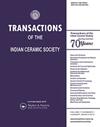利用拜耳法生产的电过滤粉末制造高温结构绝缘体(HTSI)
IF 1.5
4区 材料科学
Q3 MATERIALS SCIENCE, CERAMICS
引用次数: 0
摘要
电滤粉(EP)是拜耳法煅烧氢氧化铝过程中大量产生的残留物。提出了用EP生产高温结构绝缘子的方法。使用不同比例的起始材料进行不同的试验,尽管最佳混合物含有(wt%)52%的EP、14.7%的硅灰(或石英)、12%的耐火铝水泥和21.3%的水。此外,将900cm3的聚苯乙烯薄片添加到混合物中以促进孔隙的精细结构。砖是在硅胶模具中使用手动混合和振动压实形成的。然后,将其在100°C下干燥24小时,然后通过加热至1050°C进行预烧结,最后在1400°C或1450°C下烧结2小时。在该过程结束时,砖包含63%的莫来石、24%的钙长石和13%的刚玉,具有以下特性:密度值在0.75和0.80 g.cm−3之间,热导率值在0.25和0.29 W.m−1.K−1之间,抗压强度值高于3.5 MPa,总孔隙率在75–79%范围内,在1400°C下24小时的过热稳定性没有明显的尺寸变化。图形摘要本文章由计算机程序翻译,如有差异,请以英文原文为准。
Manufacture of a High Temperature Structural Insulator (HTSI) Using Electrofilter Powders Generated in the Bayer Process
Electrofilter powder (EP) is a residue generated in large amounts during the calcination of aluminium hydroxide in the Bayer process. The production of high temperature structural insulator (HTSI) using EP is proposed. Different tests were made using different proportions of the starting materials, although the optimal mixture contained (in wt%) 52% EP, 14.7% silica fume (or quartz), 12% refractory aluminous cement and 21.3% water. Besides, 900 cm3 of polystyrene flakes were added to the mixture to promote a fine structure of pores. The brick was formed using manual mixing and vibration compacting in silicone molds. Then, it was dried at 100°C for 24 h, and after that, subjected to pre-sintering by heating up to 1050°C, and finally it was sintered at 1400° or 1450°C for 2 h. At the end of the process, the brick comprised 63% mullite, 24% anorthite and 13% corundum, with the following properties: density values within 0.75 and 0.80 g.cm−3, thermal conductivity values within 0.25 and 0.29 W.m−1.K−1, compressive strength values higher than 3.5 MPa, total porosity in the range 75–79% and overheat stability at 1400°C for 24 h with no appreciable dimensional changes. GRAPHICAL ABSTRACT
求助全文
通过发布文献求助,成功后即可免费获取论文全文。
去求助
来源期刊

Transactions of the Indian Ceramic Society
工程技术-材料科学:硅酸盐
CiteScore
2.40
自引率
8.30%
发文量
12
审稿时长
2.3 months
期刊介绍:
Transactions of the Indian Ceramic Society is a quarterly Journal devoted to current scientific research, technology and industry-related news on glass and ceramics. The Journal covers subjects such as the chemical, mechanical, optical, electronic and spectroscopic properties of glass and ceramics, and characterization of materials belonging to this family.
The Editor invites original research papers, topical reviews, opinions and achievements, as well as industry profiles for publication. The contributions should be accompanied by abstracts, keywords and other details, as outlined in the Instructions for Authors section. News, views and other comments on activities of specific industries and organizations, and also analyses of industrial scenarios are also welcome.
 求助内容:
求助内容: 应助结果提醒方式:
应助结果提醒方式:


